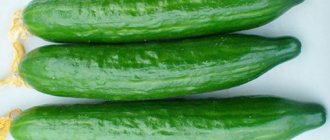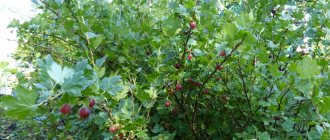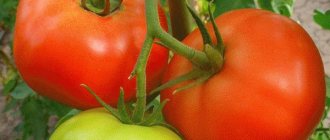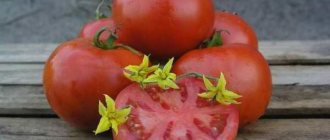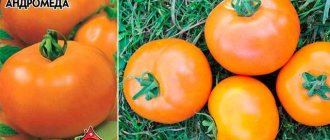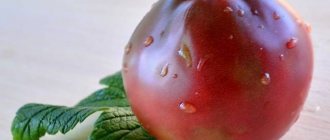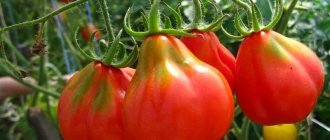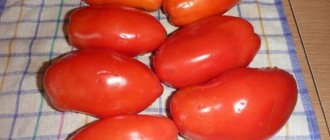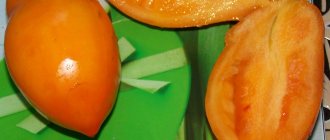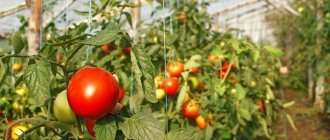The variety of pink tomatoes is so great that you are often at a loss as to which one to choose. The Pink Stella variety definitely stands out from many others due to the taste of its fruit. Ripe raspberry-colored vegetables are saturated with vitamins B and C. A small percentage of acidity allows the fruits to be used for baby and dietary nutrition. Small compact bushes will decorate any summer cottage. The culture is so easy to care for that it is recommended even for novice gardeners.
This article presents photos and descriptions, characteristics and reviews of the Pink Stella variety.
Characteristics and description of the variety
The Pink Stella tomato variety was bred by Altai breeders and is intended for breeding in warm regions, but is successfully grown in areas with temperate and cold climates. It takes root equally well both in greenhouse conditions and in open beds.
Distinctive features
Determinate type, standard, compact, 50-60 cm high .
The foliage is medium, the leaves are elongated, dark green. One cluster bears 6-7 fruits; clusters are formed frequently, every other leaf. Mid-early variety , 105-110 days pass from the moment of sowing the seeds to full ripening.
The yield is excellent , up to 3 kg of fruit is harvested from 1 seedling, provided that 3 plants are planted per 1 sq. m. m.
The culture's immunity includes high resistance to most insect pests and diseases characteristic of the nightshade family.
Low-growing bushes do not require pinching, but you cannot do without a garter: the fruit-bearing branches cannot support the weight of ripe vegetables.
Fruit characteristics
The average weight of one tomato is 170-180 g, the shape is pepper-shaped , elongated, the color is pink-raspberry. The taste is pronounced, sweet-dessert with barely noticeable sourness, the flesh is juicy. The peel is thin but dense, cracking in dry weather with a lack of moisture. There are 4 seed chambers, few seeds.
The purpose of tomatoes is universal : they are used fresh and for winter preparations. Suitable for processing into tomato products. Ripe tomatoes make excellent juices, not only canned, but also freshly squeezed.
The photo shows Pink Stella tomatoes.
Typical diseases
The Pink Stella tomato has a good immune system that reliably protects tomatoes from major diseases to which most crops can be exposed. Despite this, it is recommended not to forget about prevention, it consists of the following:
- Before planting, seeds are disinfected with potassium permanganate or copper sulfate.
- Moderate watering and loosening protect plantings from rot.
- When late blight appears, it is necessary to destroy those parts of the plants that are already infected and treat the crop with solutions containing copper.
- Insecticidal agents help in the fight against spider mites, whiteflies, and thrips.
- You can get rid of aphids with a solution of laundry soap.
- Ammonia saves you from naked slugs.
Tomato diseases
This variety is ideal both for gardeners with experience in growing tomatoes, and for those who are dealing with tomatoes for the first time. If agrotechnical errors occur, the plant will calmly survive and produce a rich harvest.
How to grow seedlings
Seeds for seedlings begin to be sown 2 months before planting in the ground . The seed material is collected independently, since the variety is not a hybrid, which means that the varietal advantages are preserved in the next generation.
Seed preparation
The seeds are laid out on the table and carefully inspected for visible damage. Suitable specimens must be light-colored and free of distortion. They are then immersed in a saline solution for 10 minutes. This is how they check whether the grains are empty or not. Those that have floated to the surface are not suitable for landing. Afterwards, the grain is disinfected in a weak solution of pinkish potassium permanganate for 20 minutes. Then rinse with running water and dry.
To improve germination, seeds are soaked in a growth stimulator for 12 hours.
Reference. In addition to specialized drugs, melt water or aloe juice are used as growth stimulants.
Container and soil
The soil is prepared from turf soil, peat and humus in a ratio of 2:2:1 .
All components are thoroughly mixed and the resulting mixture is disinfected by heating in the oven for 15 minutes at a temperature of 50°C. Another way is to spill the soil with a hot solution of potassium permanganate. After the soil has cooled , it is laid out in planting containers, having previously made small drainage holes at the bottom where excess moisture will drain.
Planted in a common wooden box or individual containers . Plastic cups and peat pots are the most common and convenient way to propagate seedlings, because when planted in a separate container, seedlings grow and develop better. In addition, plastic containers are lightweight, which does not cause difficulties when transporting planting containers to a summer cottage.
Reference. Disinfected soil is the key to healthy and strong immunity of seedlings.
Sowing
Seeds are sown in grooves 1 cm deep at a distance of 1-2 cm from each other . Sprinkle the soil on top, level it and lightly moisten it with warm, settled water. Then the containers are covered with film or glass to create a greenhouse effect and left in a warm room at a temperature of 23-24°C. The film is periodically removed for ventilation and the top layer of soil is moistened as necessary.
Growing and care
1 week after sowing, the appearance of the first shoots is noticeable . The film is removed and the containers are placed on the windowsill, but not in direct sunlight. The duration of daylight should be at least 14 hours, so there is a need for additional lighting with fluorescent lamps.
Reference. Direct exposure to sunlight can cause burns to young plants.
Water as the top layer of soil dries along the edge of the nursery with warm, settled water using a shallow watering can. After watering, the soil is loosened superficially, without touching the young roots.
The room temperature during the seedling period is maintained at 22°C, and the night temperature should not fall below 16°C.
There is no need to water abundantly , as the sprouts will begin to stretch, which is undesirable in the initial period. To ensure that the seedlings grow straight, they are periodically turned to the window in different directions.
About other varieties of pink tomatoes:
A variety with amazing taste - Raspberry Giant tomato
Early ripe tomatoes for juices, salads and canning “Fatima”
Mid-season variety with fruits, like from the picture - “Major” tomato
After 2-3 true leaves appear, the seedlings are planted , planted in separate containers. After picking, the seedlings intensively grow their root system, which has a beneficial effect on plant growth.
2 weeks before planting in the ground, seedlings begin to harden by taking them outside during the day for 1 hour at a temperature of 17-18°C. Gradually, the time spent outdoors is increased to 12-14 hours. Simultaneously with daytime hardening, the night temperature in the room is reduced to 13°C.
5 main mistakes when growing tomato seedlings
Details of agricultural technology
No matter how unpretentious the variety may be, the tomato fully reveals its potential only with good care. Pink Stella, being large-fruited, is very responsive to many agricultural practices.
Seedling period
In the description of the Pink Stella tomatoes, it is necessary to mention a valuable feature: the tomatoes are extremely compact in seedlings. The plants tolerate shading well and grow normally even on the northern and western windows of city apartments. Young seedlings of the varieties Boets (Buyan) red and Buyan yellow behave in a similar way. The stems are stocky, with close internodes, and wide foliage. Only Pink Stella has larger, slightly curly leaves.
The tops of the seedlings stretch out a little and become thinner only when they become very thick, so you should not be late with picking. It is carried out after the growth of one or two true leaves. Extreme heat can also trigger abnormal growth. There is no need to overfeed the seedlings; you can do without fertilizing altogether.
A common mistake made by beginning gardeners is sowing Pink Stella seeds too early. In the case of this variety, overgrown seedlings are much worse than undergrown ones. The age of plants when transferred to soil should not exceed 50 days. Thus, the seeds must be sown two months before planting. If you first place the plants under shelters, then the approximate planting date in the conditions of the Middle Zone and Siberia is mid or late May. This means that sowing takes place on March 15–20.
When planting directly in open ground (June 10 - 20), they are sown even later - in mid-April.
In the ground
Two circumstances play a decisive role in caring for the Pink Stella variety. It must be remembered that this is a determinate and large-fruited variety:
- On one square meter of beds place 4 - 5 bushes.
- Staking the plants is mandatory, otherwise the tomatoes will die or break under the weight of the heavy fruits. There is no need to tie each brush, it is quite strong.
- It is highly advisable to carry out the stepson below the first brush. This will speed up fruit filling and ripening, increase the size of the tomatoes and the overall yield. Remove excess shoots that emerge from the ground, and all lateral branches growing from the leaf axils below the first ovary.
- It is not necessary to plant steps above the first brush.
- There is no need for topping (removing the growing point) in August. The bushes themselves complete their growth.
- Feeding and watering of tomatoes is carried out as usual.
- It is important to observe crop rotation and take protective measures against late blight.
Pink Stella is not a hybrid, but a variety, so you can save the fruits from the best bushes for seeds. To do this, it is recommended to choose healthy tomatoes with typical varietal characteristics, preferably from the second bunch.
How to grow tomatoes
After 55-60 days, the seedlings are ready for planting in the ground . Seedlings are planted in open beds 2 weeks later than in greenhouse conditions. By the time of transplantation, the soil should be warmed to 16-17°C.
Landing
Before planting tomatoes, the soil is treated with copper sulfate at the rate of 1 tablespoon per 1 bucket of water to prevent fungal diseases. Then the soil is dug up with the application of mineral fertilizers.
Planting pattern : 40 cm – distance between seedlings, 60 cm left between rows. For 1 sq. m place 3 plants. Planted in holes 20 cm deep, at the bottom of which a little wood ash is first placed. After transplantation, the holes are compacted, watered with warm, settled water and the young bushes are left to adapt to the new conditions for 9-10 days. During this period, the plants are not watered or fed.
Further care
Regular watering is established no more than 2 times a week . The best time for watering is evening or early morning. Water with warm water, under the root, without getting on the leaves. Sprinkling is not recommended, since in addition to sunburn, plants can develop blossom-end rot. On dry days, the amount of watering is increased. The crop also consumes more moisture during fruit formation.
Reference. Sprinkling is a method of irrigation in which water, often with the help of special devices, is sprinkled in the form of rain over the soil surface and plants.
After watering, the ground is loosened, removing weeds with roots . Loosening saturates the root system with oxygen and disrupts the usual habitat of many pests living in the ground.
Hilling, like loosening, promotes better penetration of oxygen and strengthens the rhizomes, resulting in the formation of a strong stem. Hilling is carried out no more than 3 times during the season. This is quite enough to form a full-fledged stem.
Throughout the growing season, the crop is fed 4 times.:
- The first fertilizing is applied 3 weeks after transplantation. Fertilizers - “Ideal” and “Nitrophoska”. 1 tbsp. l. dissolve in 1 bucket of water and pour 0.5 liters under the bush.
- During flowering, apply a second fertilizing with Signor Tomato fertilizer at the rate of 1 tbsp. l. for 1 bucket of water. For each seedling, 1 liter of solution is used.
- The third feeding is applied 10-12 days after the second. Fertilize with “Ideal” and “Nitrophoska” in the same proportions as the first time.
- Fertilize with superphosphate for the fourth time. The solution is prepared from 1 tbsp. l., diluted in 1 bucket of water. For 1 sq. m consume 10 liters of solution.
Features of care and possible difficulties
Low-growing bushes do not require pinching . They are formed into 3 or 4 stems, all other shoots are removed. The plant does not throw out side shoots in the future, so they are not pruned. Large leaves that block the penetration of sunlight are cut off. Also remove those branches that have stopped bearing fruit.
For gartering, a wooden or metal support is installed next to each bush during transplantation , to which the stem is fixed. Immediately after transplanting, tie the stem so that it grows evenly. In the future, fruit-bearing branches are also fixed to the support, since they cannot support the weight of ripe vegetables.
Diseases and pests
The culture is distinguished by strong immunity to tobacco mosaic virus and late blight . But it is susceptible to attacks by the Colorado potato beetle, which cause irreparable harm to plants. In addition, females lay eggs on the back of the leaves, which cannot be noticed unless the leaves are turned over when inspecting the plants. Colorado potato beetle larvae are no less dangerous than adult individuals.
To scare away this pest, mustard bushes are planted next to the tomatoes . Their pungent smell irritates many insects, and they try not to approach such beds. If the insect managed to reproduce in large numbers, use the drug “Prestige”. Otherwise, all the leaves will be eaten and the crop will die.
Attention! The most effective preventive method is regular inspection of seedlings for changes due to disease or the presence of insect pests. It is always easier to prevent any problem than to deal with it later.
Varietal features
Detailed characteristics and descriptions of the variety reveal a whole range of its remarkable advantages.
They appear not only on Siberian soil. This is the largest of the early tomatoes and the earliest of the large ones. Plants bear fruit well in open-air garden beds. They can be planted in greenhouses as a low compactor. The variety is extremely unpretentious and can be grown in any weather. Not too picky about agricultural technology. May suffer from late blight.
The leaves are large, dark green, and sit on thick, short petioles. The powerful leaf apparatus ensures excellent photosynthesis and works excellently for the harvest.
The tomato stem grows about half a meter in height. At the beginning of the growing season it is of a standard type, thick, stocky, erect, compressed, extremely compact, then it becomes a little spreading. Thanks to its determinacy, this tomato stops growing on its own after setting several trusses. Early pinching (before the first cluster) accelerates ripening and increases yield. No further shaping is required.
Fruiting
Tomato ripening time is mid-early.
The clusters begin to form quite early - after the rapid growth of 7 - 8 leaves. Further, the ovaries are located often, through the leaf, which ensures excellent yield. Each brush successfully produces 3 – 5 or even 7 tomatoes. The ovaries quickly increase in size.
The weight of the fruits of Pink Stella averages 130 - 150 grams. In the first brush they are much larger - 250 - 350 grams each (record even 400 - 500). On the upper clusters, the tomatoes in shape and size resemble the fruits of the Fighter (Buyan red) variety with a weight of 70 - 90 grams.
The shape of tomatoes is elongated and pepper-shaped, narrowed downward, often slightly pointed. The first, largest fruits are kidney-shaped or heart-shaped, slightly flattened on the sides.
The color is uniform, without a green spot on the stalk. The color is very beautiful, appetizing - light crimson or deep pink. The skin is not too tough. The flesh is pink, has medium density - moderately fleshy, moderately juicy. There are very few seeds and they are small. The taste of tomatoes is excellent - dessert, sweetish.
The yield of the variety is stable over the years. Pink stella bears fruit well in any summer, despite natural disasters. Tomato clusters set successfully and grow quickly in a variety of weather conditions. The minimum return per square meter is 7 kilograms. It’s realistic to get one and a half times more.
Purpose
Pink Stella is the most unpretentious of the sweet salad varieties. The tomato is ideal for consumption in its natural form in fresh vegetable salads. The only drawback of the variety (inherent, however, in all delicious salad varieties) is the low shelf life of ripe fruits. Green tomatoes ripen well, but they are not stored ripe for long.
In terms of size and shape, Pink Stella tomatoes from the top clusters are quite suitable for pickling and pickling. True, due to the thin skin and delicate consistency of the pulp, the fruits often burst when heated. The most successful way would be to preserve tomatoes in pieces in gelatin - this is just for meaty varieties. The thick juice is tasty and sweet: if you have a large harvest, you cannot let it spoil. You can make “horseradish” (“horloder”) or cook ketchup or tomato paste.
The nuances of breeding in open ground and in a greenhouse
The culture is intended for cultivation in open ground and in greenhouse conditions . The height of greenhouse plants is practically no different from street plants; they are just as low and compact. Temperature changes do not affect the quantitative indicator, since the tomato is adapted to lower temperatures.
The culture is demanding on lighting, starting from the seedling period . With a lack of light, young plants stretch out, and later in shaded places ripening occurs later, and small fruits are formed.
Moderate watering is necessary to prevent ripe vegetables from cracking . If the plant is not watered for a long time in dry weather, and then immediately watered abundantly, an excess of moisture will negatively affect the taste and quality of the tomatoes.
Ideal predecessors of tomatoes are winter or legume crops, carrots, cabbage, and cucumbers. Crop rotation rules strongly recommend not to plant tomatoes in the place where crops from the nightshade family previously grew. They pull most of the nutrients from the soil, so the tomato will experience a constant lack of beneficial microelements in depleted soil.
History of tomato breeding Pink Stella
The Pink Stella tomato appeared as a result of research by breeders from Novosibirsk, who sought to develop a variety for Siberian conditions.
But as a result, this type of vegetable crop has gained popularity in other regions of the country. The tomato was included in the State Register of Breeding Achievements more than 10 years ago. frame src='
Initially, the variety received a different name - for several years the tomatoes were sold under the name Superheart-shaped. However, this name was later considered unsuccessful due to its excessive length. Therefore, the tomato was subsequently named Pink Stella.
Harvesting and application
Harvesting begins in late July - early August and, thanks to long fruiting, continues until the first frost. Ripening is not smooth; the last tomatoes are picked green. They ripen well at home, while in the garden beds at this time the risk of fungal diseases increases.
The purpose of tomatoes is universal : they are used to prepare a variety of dishes, from the simplest summer salads to hot and vegetable dishes. Ripe vegetables make excellent freshly squeezed and canned juices, where the characteristic sourness of tomatoes appears. Also, tomatoes do not lose their taste in barrel pickling, marinades and processed tomato products: ketchups, pastes, lecho, adjika.
Advantages and disadvantages of the variety
The variety has many positive characteristics:
- low growing bushes;
- ease of care;
- adaptation to any weather conditions;
- does not require pinching;
- persistent immunity to diseases;
- excellent yield;
- excellent taste of fruits;
- long fruiting;
- versatility in cooking;
- long storage;
- long transportations.
The negative aspects include the obligatory garter and a constant moderate watering regime, otherwise the skins of the vegetables will crack.
Farmer reviews
Several reviews from gardeners who prefer this crop to other varieties of tomato.
Natalya, Magnitogorsk : “My favorite variety. I have been planting it for many years and will never give up. Unpretentious and disease-free, not afraid of bad weather, always produces abundant fruit. It is universal in cooking, the fruits are beautiful and tasty. I recommend it to everyone."
Vladimir, Samara : “I saw the tomato for the first time in photographs, I was impressed by its low growth and excellent yield. I grew it in open ground and collected almost a bucket of delicious vegetables from 1 seedling. I especially liked the canned food and fresh salads.”
